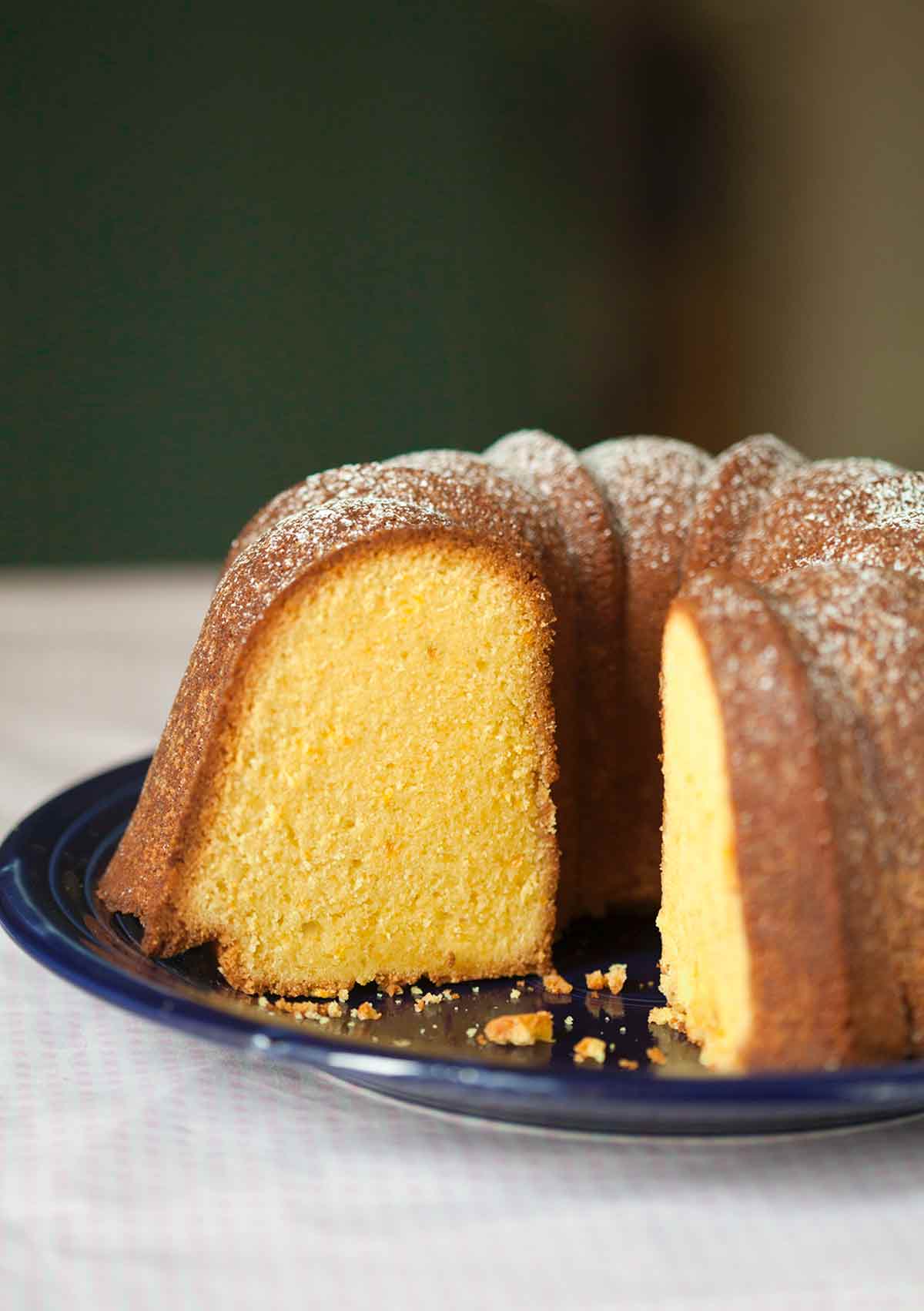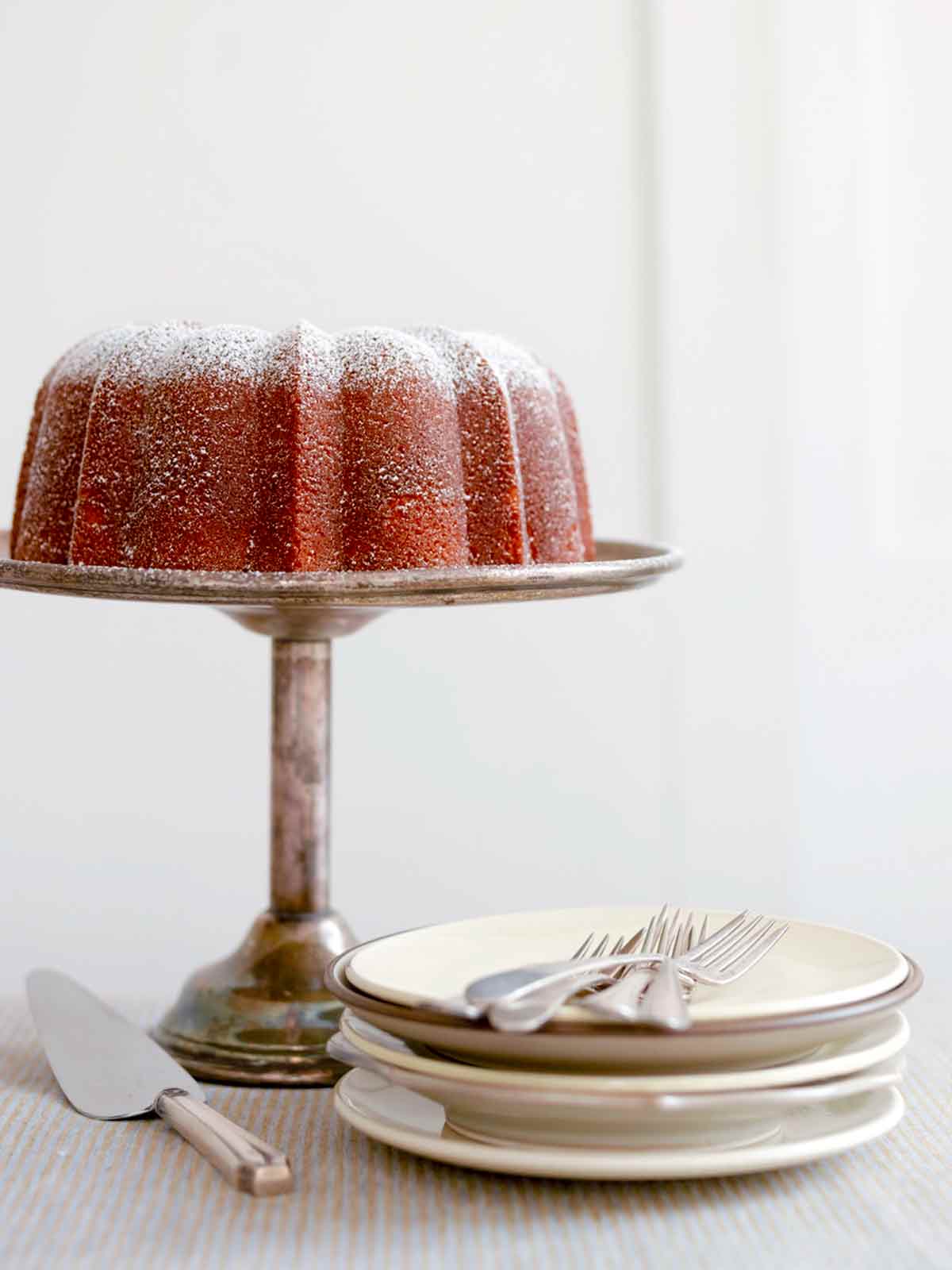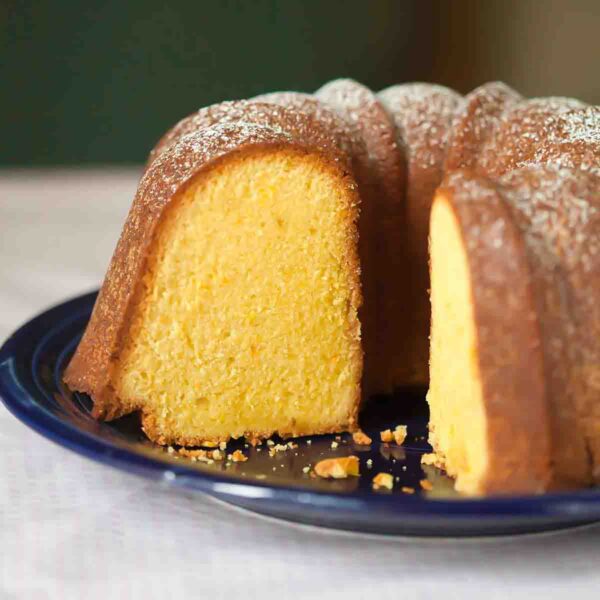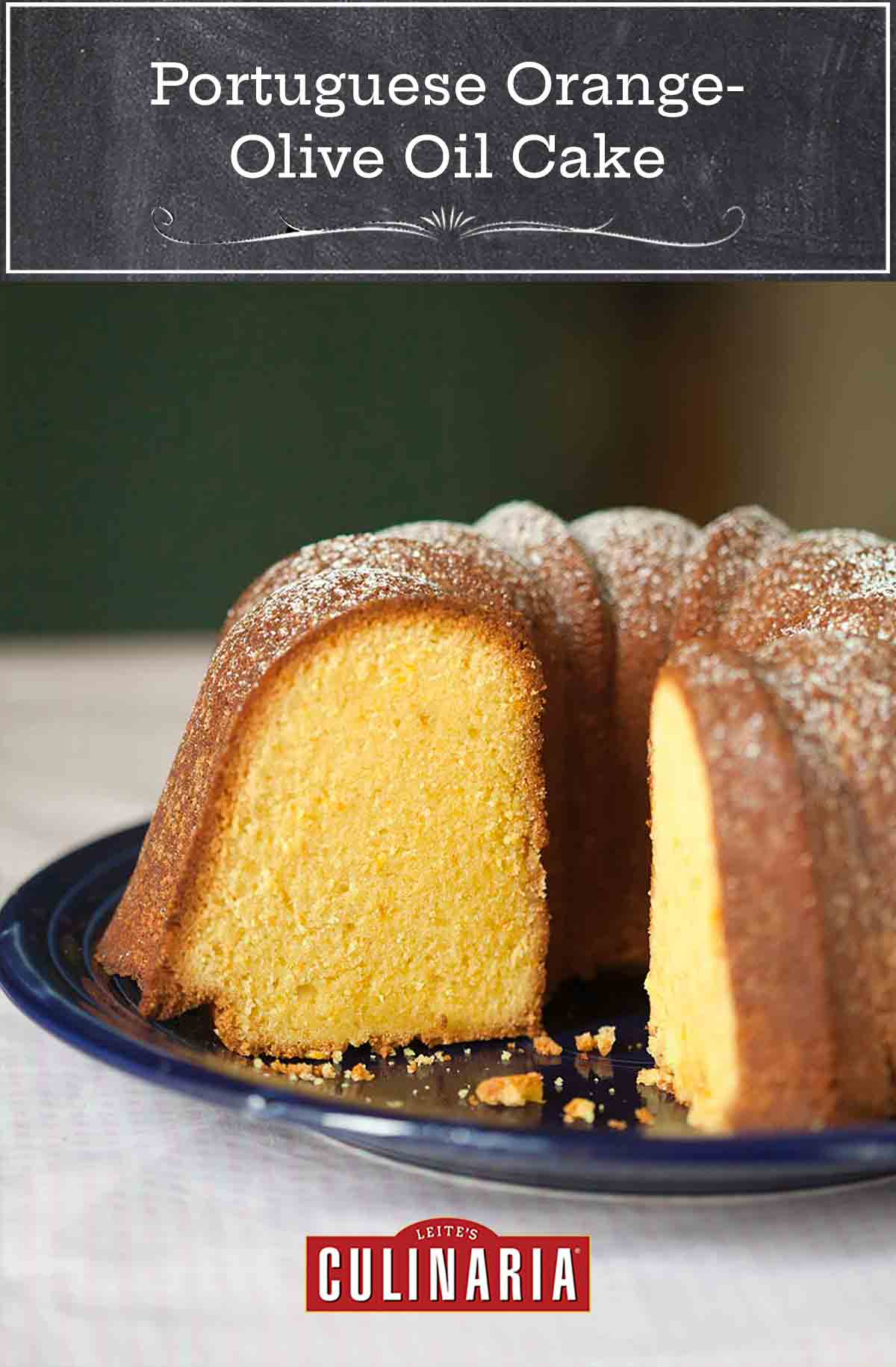
It may not look it, but this orange olive oil cake recipe was, without a doubt, the hardest recipe to develop for my first cookbook, The New Portuguese Table. We made 13 versions of it until I knew it was as good as the recipe I got at Papas, the tiny restaurant up the hill from my apartment in Lisbon. The problem was—and I have no idea if this was intentional—but they gave me a recipe for a classic chiffon cake. Yet their mighty bolo de laranja was dense and rich, and just one slice could satisfy even my appetite.

Friend and Portuguese food scholar Janet Boileau was also smitten with Papas’ orange olive oil cake and went to work with me and my recipe tester, Cindi Kruth, trying to figure it out. In the end, it took a call to Lisbon chef Fausto Airioldi to help me get a handle on the dessert. He agreed with me that this was no stinking light and airy chiffon cake. It was too full of the bold flavors of Portugal. That’s when Cindi and I started from scratch. Several weeks later, we came up with this cake.


Over the years, I’ve been mightily blessed with all sorts of compliments and accolades for this cake. Some folks have won baking contests with it. One reader used it as the base for her wedding cake. And it’s even featured in a Parisian bakery. (In a smaller, more twee version, naturellement!) But perhaps the compliment I love the most came from 10-year-old Hilton. He’d just woken up and had sat down to breakfast. After a few bites of the cake, he turned to his mother and said…
This is the best thing I ever ate. And I’m already 10!
Hilton
Portuguese Orange Olive Oil Cake FAQs
Video: How to Make This Cake

Portuguese Orange Olive Oil Cake
Equipment
- 12-cup Bundt or tube pan (Make sure to use a light-colored Bundt pan. A dark one will turn out a cake that sticks and is unpleasantly brown. The pan I use is Nordic Ware's Anniversary 15-Cup Bundt Pan.)
Ingredients
- Nonstick baking spray with flour
- 4 to 5 large navel oranges
- 3 cups granulated sugar
- 3 1/2 cups all-purpose flour
- 1 1/2 teaspoons baking powder
- 1 3/4 teaspoons kosher salt
- 5 large eggs
- 1 1/2 cups mild, fruity extra-virgin olive oil
- Confectioners' sugar, for sprinkling
Instructions
- Position a rack in the middle of the oven, remove any racks above it, and crank up the heat to 350°F (180°C). Coat a 12-cup Bundt or tube pan with baking spray and set aside.
- Finely grate the zest of 3 oranges into a medium bowl and rub the sugar into it with your fingertips. Set aside.
- Squeeze the juice from 4 oranges. You should have 1 1/2 cups orange juice; if not, squeeze the fifth orange.
- In a large bowl, whisk together the flour, baking powder, and salt.
- In the bowl of a stand mixer fitted with a paddle attachment or with a handheld mixer in a large bowl, beat the eggs on medium-high speed until well combined, about 1 minute. Slowly pour in the orange sugar and continue to beat until thick and pale yellow, about 3 minutes.
- Switch to low speed and alternate adding the flour mixture and the oil, starting and ending with the flour and beating until just a few wisps of flour remain. Slowly drizzle in the orange juice, with the mixer on its lowest setting, to bring the batter together.
- Gently scrape the batter into the prepared pan and bake until a cake tester comes out with a few moist crumbs clinging to it, about 1 1/4 hours. Check the cake occasionally and if the top begins to brown a touch too much, loosely cover it with foil.
- When the cake is done, place the pan on a wire rack and let the cake cool in the pan for 15 minutes. (Don't forget to come back after 15 minutes. Seriously. If the cake remains in the pan too long, the sugars begin to cool and stick to the pan.)
- Turn the cake out onto the wire rack and let it cool completely. (We know. Resist the temptation.) Place the cake on a covered cake stand and let it sit overnight.
☞ TESTER TIP: Seriously. This dense, moist, fruity cake only gets better with age. Don't even think about taking a bite until the day after you make it—or even the day after that.
- Just before serving, dust with confectioners' sugar.

Nutrition
Nutrition information is automatically calculated, so should only be used as an approximation.
Recipe Testers’ Reviews
This orange olive oil cake is an epiphany. It is literally the most fantastic, wondrous creation to ever grace my kitchen. The smell while it’s baking tantalizes, the taste when it’s removed from the oven mesmerizes. Thank you, David, thank you. I cannot wait to make this for everyone I know and let the worshiping begin!
I made the recipe exactly as written. Has anyone tried this with another citrus?
After reading the description of this orange olive oil cake, I couldn’t wait to make this recipe. The cake turned out just as wonderfully delightful as I had imagined. I waited the full 2 days before cutting into it and I’m glad that I did. It’s moist and decadent.
I made this cake for Easter brunch and I was nervous the cake may be too sweet for a few of my guests who don’t eat sweets, so I cut the sugar down to just under 2 1/2 cups with great success. Surprisingly, I could have enjoyed the cake a bit sweeter, and I usually don’t like cakes too sweet, so I imagine the 3 cups would make a perfectly sweet and fabulous cake.
The cake was displayed on our counter in a glass-covered cake dome for about 5 days and it remained moist until it finally completely disappeared.
Here’s the hit of a recent charity bake sale! Easy and a real keeper—the note advising not to cut into the cake on the first day was my first clue how perfect it would be for a bake sale or other need to plan ahead.
I did cut into it on the first day, though, and it was very moist, but not at all in a negative way. It was equally wonderful and perfectly moist on the second day, and I cannot report further, as it was completely devoured on day two—or sold, as it went to a bake sale.
Customers loved the cake and specifically inquired about it. If I make this for a public event again, I’ll attach little tags with a link to the recipe on this site! It’s easy to make and quietly delicious.
I noted the 12-cup Bundt pan specified and divided the recipe into a 9-cup Bundt pan, four mini-Bundts, and a 3-cup “garden bug” Bundt pan that makes five different varieties, including a dragonfly and a ladybug. The bugs were not only charming but tasty. They and the mini Bundts, attractive and impressive, were both standouts at the bake sale for their visual appeal as well as their taste.
The first time I made the cakes, I poured all the batter into these two pans; on my second test batch, I didn’t fill the molds quite as full and made a second set of the bugs in the 3-cup pan. I had no trouble reducing the baking time down for these smaller cakes, and, in fact, the quick bake time for them added to the appeal of this cake. And on top of the delicious flavor and charming Bundt shapes of this sweet orange dessert, it’s a lovely yellow color, sunny, upbeat and attractive.
It took the full 5 oranges to make the required amount of juice. I used a handheld mixer with successful results. After the 15-minute cooling period, the cakes turned out perfectly from the light-colored Bundt pans I used.













David
I submitted them via Let’s tawk…. Well, I went back to the kitchen and decided to repeat first the Epicurious lemon-olive oil cake because I live in a nature reserve in the countryside and have limes all around the place. It turned out perfectly. The toothpick test was ok and the cake done this time. The trouble is the oven, it goes either very low or very hot (>280 C), so I decidee to risk a litle bit on the high temperature side and keep an eye on the cake while baking, covered it with foil around 30m baking and took it out around 40. I think that because I’ve open the oven around 30m, it shrunk a little. I inverted the cake and it stood the test and then took it out very nicely when it cooled. So, now I’ll go back to your cake halving the recipe…still have to buy the oranges :). Thank you!
Jorge, my pleasure. So glad you pinpointed the culprit. A capricious stove is often the cause of uneven baked goods.
Hi David,
I finally made the orange cake again, halving the recipe for 3 eggs, 270g flour, 330g sugar, 230ml orange juice and baked it for 45 minutes using the same (and only) oven I have around here. I’ve put aluminum foil over the top at around 30m of baking and it came out perfect. Actually I think it was probably done around 40, but just didn’t want to risk.
The ‘raisin-like’ crumbs on top of the cake are chopped pieces of apricots (120g), but I didn’t managed to get them distributed randomly through the batter, they “dove” to the bottom and cause some extra stickiness and a small “accident” when I took it out of the cake pan. Usually with another orange pound like cake recipe (with butter) it works by rinsing the chopped apricot pieces in 5-10g of flour and folding then to the batter. Any idea on how to fold pieces of dry fruits or nuts on this type of batter, like English fruit-cakes, so that they don’t drop to the bottom? The apricot flavor combines delightfully with the orange tanginess. A solution would be to add a light sugary orange glaze with these chopped apricot pieces on top.
I’m quite happy with the result, and will be making it more times (orange season is just starting here in Portugal), especially if I find a standing mixer, because beating those eggs with a hand whisk to ribbon stage takes a little more than 40 minutes (that is why I halved the recipe to 3 large eggs :)! – Thank you very much for sharing this delicious recipe!
Jorge, first you must be commended for 40 minutes of hand beating. I think there’s an Olympic category for such a feat.
Anytime I want to add dried fruit, chocolate chips, nuts, etc. to a cake batter, I first rinse them with water and toss them in flour. Then into the batter they go. But that’s for a butter-based cake. This oil-based cake (which between the orange juice and olive oil contains a lot of liquid) may have a different density, and therefore the pieces do a swan dive. I suggest cutting the pieces much smaller and seeing if that helps.
Does the cake go into the refrigerator when cooled, or is one supposed to leave out on the counter in a covered cake holder?
Yvonne, the cake stays on the counter under a cake dome. No need to refrigerate it at all.
Wow…thank you very much David, for such a quick answer! I think you’re right…I will follow your advice on the oven.
The cake I inverted immediately was another one: olive oil & lemon chiffon-cake from Epicurious, which is why I inverted it promptly. That was not your recipe. Yours turned out a beautiful cake, easy to unmold (have you seen the two photos?). However, in both cakes the default test failed to reveal a still unfinished baking batter. This is what really struck me! – I think now that oily batters may reach an almost done stage where they become dense enough not to adhere to a metal blade. I will try another material soon.
I know that mixing by hand takes more time. So, this is how I have done it: It took me something like > 30 m to whip the 5 eggs, 1 Tspn orange juice and the sugar to the ‘ribbon-stage’ (ponto de letra) using a medium-large silicone balloon whisk, I guessed that was like doing ‘Pão-de-Ló’ starting from whole eggs (yolk and white not separated); then I emulsified 1/5 of the olive oil and 1 Tspn of Nutmeg + orange zest into the whiped egg mixture, then proceeded to add the flour (sifting over batter) alternating with the rest of olive oil as stated on the recipe; lastly added the orange juice. I did this more folding than beating, until ingredients were combined and the batter turned out smooth and mostly homogenous. I DID FORGOT to add the SALT!
Baking for me is like doing experimental research (I’m an Insect Taxonomist), so I will try again halving the recipe (3 eggs are much easier to whip to ribbon stage in a similar fashion that a stand-mixer would do) to a cake the size of those I usually bake. I guess it will take between 45m-1 hour to bake. You might have a point on batter handling and so I would like to downsize the problem just to oven and cooking time issue, getting rid of wrong doings while preparing the batter.
If I get it right this time, the next I will add a variation that works wonderfully with saturated fat based popular Brazilian orange cakes: add 160g (average 1 cup) of raisin size chopped dried apricots (alperces, damascos). It does wonders with the orange flavor.
Thank you very much again David!
Sorry, Jorge. I misunderstood about the inverting.
I look forward to hearing about your results. For the next time I’d suggest a few things: You don’t need to sift the flour. You also don’t need to fold in the orange juice. The batter’s not that delicate, like a pao-de-lo.
I didn’t get the pictures. It’s best to submit them here: Let’s Tawk.